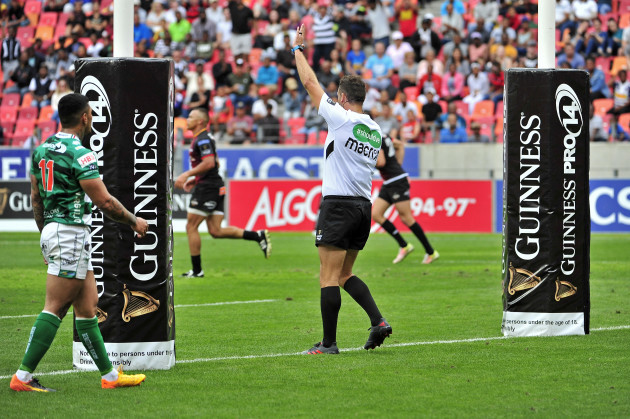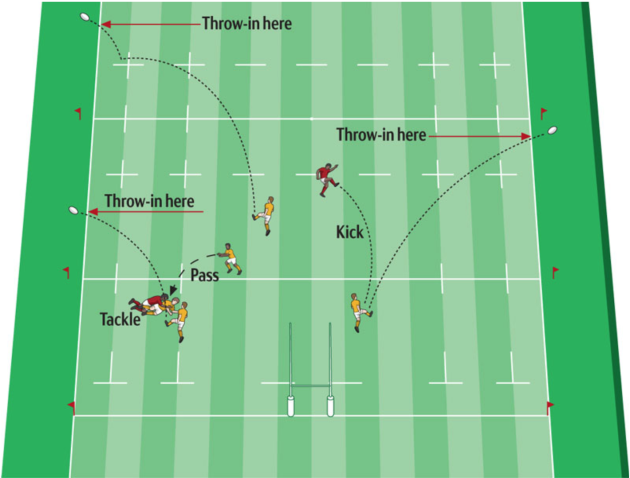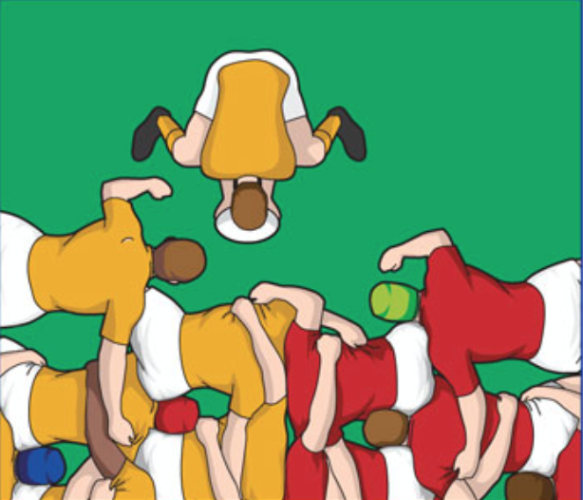WORLD RUGBY HAS announced that the current package of 12 global law trials will be adopted into rugby’s law book with immediate effect.
The World Rugby Council unanimously decided to adopt the law amendments following positive feedback from players, coaches, match officials and fans, and an evaluation by World Rugby’s 15s Laws Review Group [LRG].
The LRG includes the IRFU’s David Nucifora and ex-Ireland international Alain Rolland, now World Rugby’s head of referees, while Paul O’Connell also provided input during what has been a four-year process of reviewing and amending the laws of the game.
The global law trials that are to be adopted immediately into the law book have been in effect in the Northern Hemisphere since August of 2017, while they came into effect in the Southern Hemisphere in January of this year.
That means you have already been watching all of the below laws in action for almost five months, at least, but it’s worth just running through each of them again.
____________________
- Law 3.15 - Uncontested scrums must have eight players
This means that if uncontested scrums happen as a result of a yellow/red card or an injury, both teams must still have eight players each in the scrum.
The amendment will ensure that attacking teams from scrums will still have an advantage if it is the defensive team who has lost a player – i.e. the attacking backs will outnumber the defence seven to six.
- Law 5.7c - Permit penalty kick to touch after time has elapsed
This allows penalties to be kicked into touch and the lineout to be taken even after the match clock has run into the red.
Naturally, this prevents defensive teams from gaining an advantage by attempting to kill the game by conceding penalties after time has elapsed.
- Law 7.2 (d) - Where multiple penalty infringements occur, the non-offending team can choose the most advantageous
This means that the attacking team will have a choice of where to take their penalty from if the defence commits more than one offence during a single passage of play.
Obviously, teams will opt for the most advantageous position, whether that be for a kick at goal or a line kick to touch.
- Law 8.1c, 8.3 and 8.7 – Penalty try has no conversion
With penalty tries being awarded under the posts, where conversions are easiest, this amendment speeds the game up. A penalty try means seven points straight away.
It also ensures that offending teams get the maximum seven-point punishment just in case a kicker had somehow missed the conversion from directly under the posts.
- Law 18 and Law 21 - Touch, 22m and in-goal simplification
There are quite a few parts to the touch definitions regarding when the ball is “is not in touch or touch-in-goal”. The third part below is the amendment, but it’s worth running through the others just for clarity.
Touch definitions
Firstly, imagine a player standing close to the touchline and reaching out to grab a kick while that player still remains in the field of play. Even if the ball reaches the imaginary line coming up from the touchline ['the plane of touch'], the ball is not considered to be in touch.
Secondly, imagine a player jumping from inside or outside the touchline and catching the ball before landing in the field of play. Again, even if the ball has reached that imaginary ‘plane’ rising from the touchline, the ball is not in touch.
This one might look a bit odd if the player jumps from outside the touchline before catching and landing inside it, but where they land is the key.
Thirdly, imagine a player jumping from inside the touchline and either knocking the ball infield or catching and releasing it back infield before they land in touch. Even if the ball has reached that ‘plane of touch,’ this is play on too.
One other bit to underline here is that if a player is standing in touch and knocks or kicks the ball infield – but does not hold it – before the ball reaches the plane of touch, play continues.
All of the above also apply for the touch-in-goal line.
Who took the ball into touch?
The amendments here look to simplify what happens if a player is already touching the touchline or touch-in-goal line when they catch or hold the ball.
Essentially, if the ball has reached the plane of touch before that player catches the ball, the catcher is not deemed to have taken it into touch.
So, that means that the catcher’s team will have the throw into the lineout.
However, if the ball has not yet reached the plane of touch when that player catches it or picks it up off the ground, then the catcher has brought it into touch, regardless of whether the ball is moving or not.
That obviously means that the opposition will have the throw into the lineout.
Taking it back into the 22
As we already know, if the kicking team takes the ball back into their 22 before kicking the ball to touch – without a ruck, tackle or maul first taking place – then the opposition get to throw into the lineout from in line with where the kicking team kicked – back in their 22.
The amendment here underlines that if a player is inside their own 22 and picks up the ball while it is outside the 22, or catches the ball before it reaches the ‘plane’ of the 22, they are also considered to have taken the ball back into their own 22.
Therefore, if they immediately kick to touch, the opposition will throw into the lineout in line with where the kicking player kicked the ball – back in the 22.
In-goal
Basically, if a player is in the in-goal area and catches or picks up the ball when it’s still in the field of play, that player has taken the ball into the in-goal area.
Also, if a player is on or beyond the dead-ball-line or is in touch-in-goal and they catch or pick up the ball when it is still in the in-goal area, that player has made the ball dead.
- Law 19.15 - Scrum – no signal from ref
The scrum-half doesn’t need a signal from the referee to put the ball into the scrum.
Instead, they throw it in when the scrum is “square, stable and stationary”
- Law 19.15 (f) Scrum – alignment of scrum-half
The ball must be thrown into the scrum straight, but the scrum-half throwing the ball in is allowed to align their shoulder on the middle line of the scrum.
That means they are a shoulder-width closer to their side of the scrum. A free-kick is awarded if the feed at the scrum is not straight.
This law amendment, combined with the one below, aims to ensure that the feed is straight and there is a genuine hook in the scrums, while also appreciating that hooking for the ball is a physically difficult task for hookers under pressure in the scrum.
- Law 19.22 - Scrum – compulsory strike
This law states that “the hooker from the team which threw in the ball must strike for the ball,” with a free-kick awarded if the hooker does not strike for the ball.
Again, the intention is that there is a clear hook in scrums after a straight feed, rather than scrum-halves rolling the ball into their second row.
The LRG has underlined that only the hooker may strike for the ball, having had concerns about player welfare if other front row players were to strike.
- Law 19.36 (d) Scrum – Allow the number eight to pick up from the second row of the scrum
Previously, the number eight was not allowed to reach into the second row to pick the ball out of a scrum, but that has changed.
The obvious intention here is to ensure that the ball comes out of the scrum more often and, therefore, leads to the attacking team being able to use their set-piece possession.
- Law 14.6 - Tackler must get up before playing the ball and then can only play from their side of the tackle gate
This law prevents the previously odd sight of tacklers bouncing straight back to their feet and going for a turnover directly from whatever position they were standing in.
Now, the tackler has to get back to their feet and work around to come through the ‘gate’ on their own team’s side if they are going to compete for the turnover.
Obviously, if a ruck has formed in the meantime, they cannot then look to play the ball.
- Law 14.11 - Change in pre-ruck offside line formation – at least one player on their feet and over the ball which is on the ground
This one was, in part, a response to incidents like Italy’s clever ‘fox’ tactics against England in the 2017 Six Nations.
Before, a player from each side was required to be in contact over the tackle to form a ruck that then formed the offside lines.
Italy simply stood off from creating a ruck and that allowed them to flood around into England’s passing channels after the tackle, leaving Eddie Jones deeply frustrated.
Now, however, the offside lines are created when just a single attacking player has arrived on their feet over the tackle. Regardless of whether a defender engages with them, the offside lines are formed.
As per the law book “[e]ach team’s offside line runs parallel to the goal line through the hindmost point of any player in the tackle or on their feet over the ball.”
It’s also worth highlighting that “[i]f that point is on or behind the goal line, the offside line for that team is the goal line.”
- Law 15.16 (e) - No kicking the ball out of the ruck
This law simply states that players must not “[k]ick, or attempt to kick, the ball out of a ruck.”
This is obviously a measure to protect players on the ground, with the previous acceptance of kicking the ball out of rucks having led to a number of dangerous situations and injuries.
While kicking the ball out of a ruck is now outlawed, it’s worth stressing that players can still hook the ball back onto their own side in a ruck.
The42 is on Instagram! Tap the button below on your phone to follow us!




